Related Research Articles

Roger William Corman was an American film director, producer and actor. Known under various monikers such as "The Pope of Pop Cinema", "The Spiritual Godfather of the New Hollywood", and "The King of Cult", he was known as a trailblazer in the world of independent film.
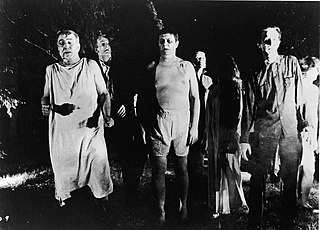
A B movie, or B film, is a type of cheap, poorly made commercial motion picture. Originally, during the Golden Age of Hollywood, this term specifically referred to films meant to be shown as the lesser-known second half of a double feature, somewhat similar to B-sides in recorded music. However, the production of such films as "second features" in the United States largely declined by the end of the 1950s. This shift was due to the rise of commercial television, which prompted film studio B movie production departments to transition into television film production divisions. These divisions continued to create content similar to B movies, albeit in the form of low-budget films and series.

Lana Jean Clarkson was an American actress and fashion model. During the 1980s, she rose to prominence in several sword-and-sorcery films. In 2003, record producer Phil Spector shot and killed Clarkson inside his home; he was charged with second-degree murder and convicted in 2009.

An exploitation film is a film that tries to succeed financially by exploiting current trends, niche genres, or lurid content. Exploitation films are generally low-quality "B movies", though some set trends, attract critical attention, become historically important, and even gain a cult following.

Catfight is a term for an altercation between two women, often characterized as involving scratching, shoving, slapping, choking, punching, kicking, wrestling, biting, spitting, hair-pulling, and shirt-shredding. It can also be used to describe women insulting each other verbally or engaged in an intense competition for men, power, or occupational success. The catfight has been a staple of American news media and popular culture since the 1940s, and use of the term is often considered derogatory or belittling. Some observers argue that in its purest form, the word refers to two women, one blonde and the other a brunette, fighting each other. However, the term is not exclusively used to indicate a fight between women, and many formal definitions do not invoke gender.

A sexploitation film is a class of independently produced, low-budget feature film that is generally associated with the 1960s and early 1970s, and that serves largely as a vehicle for the exhibition of non-explicit sexual situations and gratuitous nudity. The genre is a subgenre of exploitation films. The term "sexploitation" has been used since the 1940s.
Teenage Caveman is a 1958 American independent black-and-white science fiction adventure film produced and directed by Roger Corman, and starring Robert Vaughn and Darah Marshall. The film was released by American International Pictures in July 1958 as a double feature with How to Make a Monster.

Big Bad Mama is a 1974 American action-crime-sexploitation comedy movie produced by Roger Corman, starring Angie Dickinson, William Shatner, and Tom Skerritt, with Susan Sennett and Robbie Lee. This movie is about a mother, Wilma, and her two daughters, Polly and Billie Jean, who go on a crime spree. After the mother unexpectedly falls in love with a bank robber it all ends, with tragic consequences. Big Bad Mama became a cult hit and was followed by a sequel, Big Bad Mama II, in 1987.
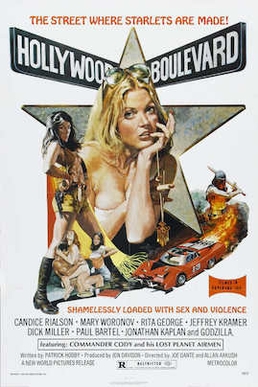
Hollywood Boulevard is a 1976 American satirical exploitation film directed by Allan Arkush and Joe Dante, and starring Candice Rialson, Paul Bartel, and Mary Woronov. It follows an aspiring actress who has just arrived in Los Angeles, only to be hired by a reckless B movie film studio where she bears witness to a series of gruesome and fatal on-set accidents. The film blends elements of the comedy, thriller, and slasher film genres.

Alexander D'Arcy was an Egyptian stage, television and film actor with an international film repertoire.

A Thief in Paradise is a 1925 American silent drama film produced by Samuel Goldwyn, directed by George Fitzmaurice, and adapted by Frances Marion from Leonard Merrick's 1900 novel The Worldlings.
Jonathan Kaplan is an American film producer and director. His film The Accused (1988) earned actress Jodie Foster the Oscar for Best Actress and was nominated for the Golden Bear at the 39th Berlin International Film Festival. His film Love Field (1992) earned actress Michelle Pfeiffer an Oscar nomination for Best Actress and was nominated for the Golden Bear at the 43rd Berlin International Film Festival. Kaplan received five Emmy nominations for his roles directing and producing the television series ER.

Night Call Nurses is a 1972 American sex comedy film directed by Jonathan Kaplan. It is the third in Roger Corman's "nurses" cycle of films, starting with The Student Nurses (1970).

The Student Teachers is a 1973 film directed by Jonathan Kaplan. It was inspired by the "nurse" cycle of pictures starting with The Student Nurses (1970). Roger Corman says it was one of the best of the cycle. It was made by the same team who had done Night Call Nurses.
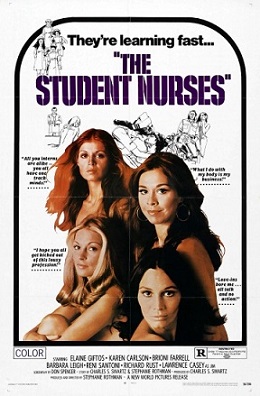
The Student Nurses is a 1970 American film directed by Stephanie Rothman. It was the second film from New World Pictures and the first in the popular "nurses" cycle of exploitation movies. It has since become a cult film.

Private Duty Nurses is a 1971 American film written and directed by George Armitage. It is a sequel to The Student Nurses (1970) for New World Pictures. Roger Corman says they got the idea for the title after being sent a letter of complaint about the first film from the Private Duty Nurses Association.
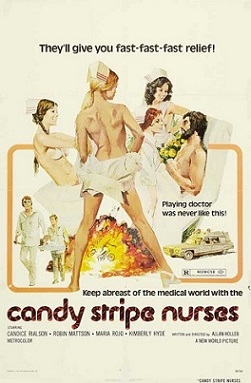
Candy Stripe Nurses is a 1974 American comedy film written and directed by Alan Holleb, and starring Candice Rialson. Produced and distributed by New World Pictures, it was the last in their popular "nurses cycle" of films that commenced with The Student Nurses (1970).

Fly Me is a 1973 exploitation film directed by Cirio H. Santiago and produced by Roger Corman. The story concerns flight attendants, international drug smuggling, kung fu, and nudity. It was poorly received by critics.

Screwballs is a 1983 Canadian teen sex comedy film that was inspired by the success of Porky's.
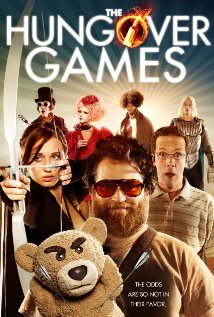
The Hungover Games is a 2014 American parody film, directed by Josh Stolberg. The film's title and central plot primarily follow both The Hangover and The Hunger Games, as well as parodying Ted, Pirates of the Caribbean, Avatar, Charlie and the Chocolate Factory, The Human Centipede, The Lone Ranger, Django Unchained, Thor, Carrie, The Muppets, Borat, Taken, The Walking Dead, and The Real Housewives.
References
- 1 2 3 4 5 Jacobs, Laura (March 2004). "The Lipstick Jungle". Vanity Fair.
- 1 2 3 4 Hornaday, Ann (31 May 2008). "Girls, Meet Gotham". Washington Post.
- ↑ Nehme, Farran Smith (11 December 2017). "Rep Diary: Roman Hollywood". Film Comment.
- ↑ Foundas, Scott (4 April 2007). "Grindhouse Gang". LA Weekly.
- ↑ Corman, Roger (1979). The movie world of Roger Corman. Chelsea House Publishers. p. 176.
- ↑ Chris Nashawaty, Crab Monsters, Teenage Cavemen and Candy Stripe Nurses - Roger Corman: King of the B Movie, Abrams, 2013 p 124